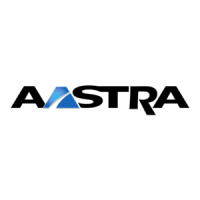Page 68 01/2007 AMT/PTD/PBX/0020/2/4/EN
Note:
You can install a LD4/LD4NX card in a non rackable NeXspan S12 if a backplane has
been added (optional). The non rackable standard NeXspan S12 cannot be fitted with
expansion cabinets. The rackable standard version is fitted with a backplane and can be
fitted with 3 expansion cards (RJ45 format).
The LD4NX card is used to manage the M bit channel by channel. For software releases before
3.2, the 4 equipment interfaces on the LD4NX card (LD4N mode) generate the M bit in the S
frame every 800 ms (factory setting). This setting can be changed to 5 ms for particular ISDN
applications (video conference, router) if the set of resistors on the card (R91 and R67) are
modified. From release 3.2, operation at 5 or 800 ms is determined automatically. The LD4NX
card access are initialized channel by channel, according to is configuration:
• DECT M bit S frame: the interface generates the M bit in the S frame to the base station every
800 ms.
• DECT master base station, DECT slave base station or non-DECT S0 terminal: the interface
generates the M bit in the S frame to the base station every 5 ms. The slave base station
does not use this synchronization; it uses only the 800ms clock transmitted by the master
base station via the third pair.
UCT-S, UCTS-12 and UCT-C cards
The UCT-S, UCTS-12 and UCT-C cards are NeXspan S, NeXspan S12 and NeXspan C CPU
cards with four T0/S0 interfaces.
The T0/S0 interfaces are used to connect:
• four 2-channel DECT base stations (on UCT1-S) and 4-channel (on UCT2-S/UCT3-S
equipped with an ADPCM16 daughter card).
• two 2-channel DECT base stations (on UCT1S-12) and 4-channel (on UCT2S-12/UCT3S-12
equipped with an ADPCM16 daughter card).
• two 2-channel DECT base stations (on UCT1-C) and 4-channel (on UCT2-C equipped with
an ADPCM16 daughter card).
The T0/S0 interfaces are configured by MMC (and by setting jumpers, see Figure 4-17:):
• as T0 for connection of an ISDN network basic rate interface,
• as S0 for connection of an ISDN terminal or DECT base station.

